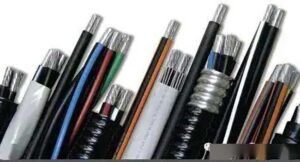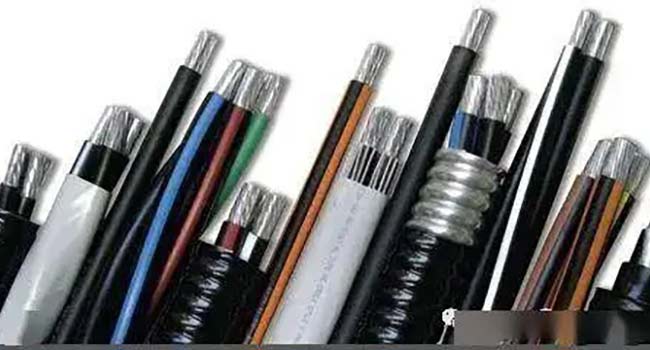단열재는 무엇입니까??
케이블 단열재는 모든 케이블의 중요한 부분입니다.. 그것은 와이어를 덮는 비전 도성 재료로 만들어졌습니다.. 전기 절연이라고도합니다.
단열재의 목적은 전류를 케이블의 나머지 부분과 분리하는 것입니다., 와이어 안에 보관하고 주변 환경에 들어가는 것을 방지합니다..
동시에, 단열재는 설치 환경의 가혹한 조건으로부터 와이어를 보호하고 적절한 작동을 보장합니다..
단열재는 다른 재료로 만들 수 있습니다, 와이어의 대상 응용 프로그램에 따라.
그러나 전반적으로, 플라스틱, 고무, 그리고 플루오로 폴리머는 가장 일반적인 유형의 와이어 단열재입니다..

Plastic Insulation
폴리염화비닐 (PVC)
Polyvinyl chloride is resistant to moisture, 불, and abrasion and can be used in many environments. 예를 들어, 산, 용매, and ozone.
PVC insulated cables also have no taste or odor, so they are not toxic. The allowable temperature range for this material is -55°C to 105°C.
Semi-Rigid (SR) PVC
SR-PVC has similar resistance characteristics to PVC 단열재, but this material is better when maximum abrasion resistance is a priority.
Leaded PVC
Plenum PVC is also made of PVC, but is best suited for installation in interior areas with air circulation, such as raised floors or dropped ceilings.
폴리에틸렌 (체육)
Polyethylene is a rigid material used when high transmission speeds and low capacitance are required.
Polyethylene is also the preferred choice for coaxial cable insulation. This material is resistant to soldering, 열분해, and solvents, and operates at temperatures between -65°C and 80°C.
XLPE (가교 폴리에틸렌) insulation is a common subtype of polyethylene insulation.
Polypropylene (PP)
PP has similar properties to PE but is mainly used in indoor environments. The allowable temperature range for this insulation is 30°C to 80°C.
폴리우레탄 (푸르)
PUR is a flexible material mainly used for cables in low-temperature and marine environments. It is resistant to moisture, 약, and abrasion and has an operating temperature range of -60°C to 90°C.
Rubber Insulation
Thermoplastic Rubber (TPR)
TPR is resistant to high temperatures and harsh weather conditions and is the best choice when high processing speeds are required.
네오프렌 (Polychloroprene)
Neoprene is resistant to abrasion, 기름, and solvents. This insulating material makes wires durable.
Ethylene-Propylene Rubber (EPR)
EPR is widely used in high-voltage cables – it is flexible and resistant to most irritants. the allowable temperature range for EPR cable insulation is -50°C to 160°C.
Ethylene-propylene-diene monomer (EPDM)
EPDM is resistant to harsh weather conditions, heat and abrasion, as well as being a strong dielectric and flexible. Its operating temperature range is -55°C- to 50°C.
Silicone
Silicone is a widely used flexible synthetic rubber insulation material. This material is particularly useful in high-heat areas as it can withstand temperatures of up to 180°C.
유리 섬유
Glass fiber is resistant to moisture and chemicals.
This glass insulation has a maximum operating temperature of 482°C and is often used in kilns, aluminum processing, and heat treatment.
Styrene-Butadiene Rubber (SBR)
SBR has similar properties to neoprene but is mainly used in Mil-C-55668 cable.
Fluoropolymer Insulation Materials
Perfluorinated alkoxy (PFA)
PFA is a robust and, 그러므로, durable insulating material that can be used in extreme temperatures (from -65°C to 250°C).
Polytetrafluoroethylene (PTFE)
Polytetrafluoroethylene is a flexible thermoplastic material that is heat, 기름, 수분, and chemical resistant.
The allowable temperature range for this material is -70°C to 205°C.
Fluorinated ethylene propylene (FEP)
FEP is typically used in down jackets and military cables due to its high flame resistance and excellent data transmission capabilities.
Polyvinylidene Fluoride (PVDF)
PVDF is also known as Kynar – it is resistant to most irritants, including flame. It is also flexible and not heavy, which makes it well suited for airy indoor environments.
Choosing the right cable insulation
The type of insulation you choose depends on the application scenario of your cable. ~에 Veri Cables, we have various types of cables with aluminum and copper conductor insulation. 예를 들어, some of our most popular products are low-voltage aluminum wires with PVC insulation and copper medium and high voltage cables with XLPE insulation. Contact us to get our latest catalog, see more products and find the wire and cable you need for your project.
